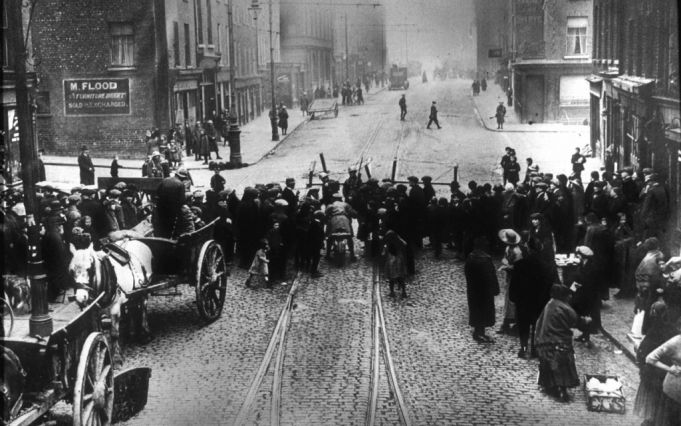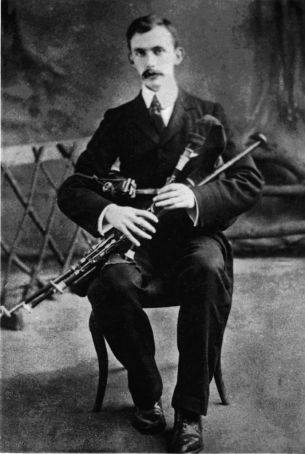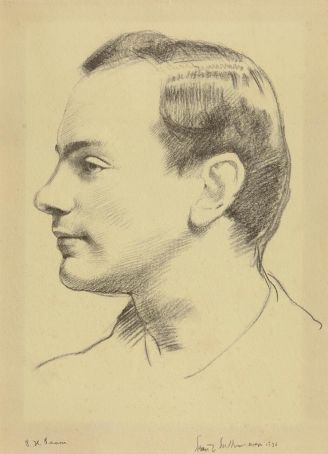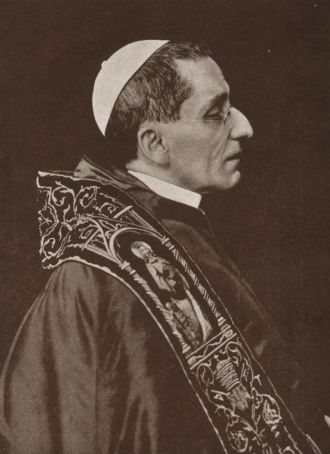Rome's religious and cultural links with Ireland's Easter Rising 100 years ago.
By Mícheál MacCraith
This year marks the centenary of the Easter Rising in Dublin, which was the violent culmination of a long campaign for Home Rule from Britain that dated back to 1870. Home Rule, passed by the British parliament in 1912, was expected to come into operation by autumn 1914. When Britain declared war on Germany on 4 August 1914, however, it was postponed until the war ended. Fearing that Britain would ultimately renege on her promises, a group of advanced nationalists came together in September 1914 and started planning to stage an uprising in Ireland at Easter 1916. Their efforts seemed doomed when a ship carrying 20,000 rifles for the nationalists from Germany was captured by British naval vessels two days before the intended insurrection was due to begin.
The General Post Office is seized
Despite the disillusionment and panic that spread through the insurgents’ ranks, not to mention the confusion caused by orders and counter-orders, a small group spearheaded by the Irish Republican Brotherhood decided to proceed with the original plans, come what may. On Easter Monday, 24 April 1916, about 1,300 volunteers seized a number of strategic buildings, most importantly the General Post Office, in the centre of Dublin and proclaimed an Irish republic. They held out for six days but, overwhelmed by superior forces and artillery, they surrendered unconditionally the following Saturday. A series of courts martial was immediately initiated and the seven signatories of the proclamation of the Republic were executed by firing squad between 3 and 12 May. Nine other leaders were also executed.
Though initially hostile to the rising, public opinion was speedily transformed by the summary and vindictive nature of the executions, not to mention the internment of 1,800 men in Frongoch in north Wales. The failed insurrection thus became a pivotal moment in accelerating the movement for Irish independence.

Due to its involvement on the Allied side in world war one since May 1915, Italy was undoubtedly not much interested in Irish affairs and Romans would have considered Ireland as part of the United Kingdom. Investigation of the leading insurgents’ lives, however, reveals cultural and religious links between the eternal city and the Easter Rising of 1916.
The leaders of the Rising and Rome
An interesting feature of the rising was the connections a number of the executed leaders had with Rome. While James Connolly, one of the signatories of the proclamation, did not visit the Eternal City, he learned fluent Italian during his time as a labour activist in order to facilitate the organisation of Italian workers in New York.
Éamonn Ceannt, the last signatory of the proclamation, was a noted player of the uilleann pipes, Ireland's national bagpipe. In September 1908 he accompanied a pilgrimage of the Catholic Young Men’s Society to Rome. The pilgrims paraded behind Ceannt, playing his pipes, to their papal audience in the Vatican. Afterwards Ceannt entered the hall and walked up and down three times, playing a well-known martial air, O’Donnell abú. When he finally ceased playing a few steps from the papal throne, Pius X summoned him forward to examine the strange instrument. Though initially startled by an “unearthly sound” that was emitted by the bag and chanter, His Holiness quickly recovered and asked him to play again. Ceannt responded with The Wearing of the Green. When he had finished the pope came down and patted him on the back, before going to meet the rest of the pilgrims.

In June 1913, Thomas MacDonagh, another signatory of the proclamation, asked Joseph Plunkett, also a signatory, to take over as editor of The Irish Review. Among Plunkett's first contributors was Patrick Pearse, later to be commander in chief of the insurgents and signatory to the proclamation. Pearse’s contribution, which ran for a number of issues, was entitled Songs of the Irish Rebels, comprising translations of martial poems in Irish composed during the previous two centuries. One of the poems selected by Pearse was An Síogaí Rómhánach, The Roman Visionary. Composed around 1650, the poem is basically a lament for the Irish military leader Eoghan Rua O’Neill who died in 1649. Weeping at the graves of the Ulster princes in S. Pietro in Montorio, the poet narrator encounters a lady from the otherworld who gives vent to her feelings about the sufferings of Ireland at the hands of the English throughout the centuries. Despite the narration of oppression and despite the death of Eoghan Rua, the mysterious lady holds out a message of hope for the future, if only the Irish can come together in unity.
Pearse and the lament of The Roman Visionary
In August 1915, Pearse delivered the graveside oration at the funeral of O’Donovan Rossa, an old Fenian who died in America and whose body was brought back to Ireland for burial. Considered to be one of the most important political speeches in 20th-century Irish history, it is memorable in particular for its closing lines, delivered before 200,000 listeners: “The defenders of this realm … think that they have foreseen everything, think that they have provided for everything; but the fools, the fools, the fools! They have left us our Fenian dead, and while Ireland holds these graves, Ireland unfree shall never be at peace.”

Very recent research has shown that the style and rhetoric of Pearse’s address was closely modelled on the poem An Síogaí Rómhánach. While the poet’s identity is unknown to us, all the evidence indicates that he was a member of the Irish Franciscan community of S. Isidoro in Rome.
Plunkett sends his father to Rome
In April 1916, Joseph Plunkett swore his father George, a papal count, into the Irish Republican Brotherhood and sent him to Rome, where he was received by Pope Benedict XV. During their conversation the pope recalled a recent audience with the British prime minister Herbert Asquith, who had informed His Holiness that the Irish question had been finally solved, now that Home Rule had been granted. Plunkett countered that Home Rule had not been implemented but rather shelved for the duration of the war. The count made the pope aware of nationalist fears that it might not be implemented at all, and even then only with the provision of an amending act to cater to the wishes of the Unionist population of Ireland. Briefing His Holiness on the real situation in Ireland, Plunkett informed him that an insurrection was in the offing. Speaking in French, he asked the pope to send his blessing to those who were setting out on an enterprise they believed to be just.
Audience with Pope Benedict XV
Geraldine Plunkett, one of the count’s daughters, recalled her father narrating this episode, noting that tears of sympathy streamed down the pope’s face as he gave his blessing, uttering: “Les pauvres hommes, les pauvres hommes.” When Plunkett arrived back in Ireland on 20 April he immediately set about visiting various bishops around the country, begging them to refrain from condemning whatever action might take place.

Because so many people scoffed at the idea of Pope Benedict XV giving the insurgents his blessing, Plunkett wrote to The Irish Press on 26 May 1933 and gave his own account of the event in Rome:
“I was received in private audience by His Holiness; for nigh two hours we discussed freely the question of the coming struggle for Irish Independence. The Pope was much moved when I disclosed the fact that the date for the Rising was fixed, and the reasons for that decision. Finally I stated that the Volunteer Executive pledged the Republic to fidelity to the Holy See and the interests of religion. Then the Pope conferred his Apostolic Blessing on the men who were facing death for Ireland’s liberty.”
Recent research in the archives of the archdiocese of Dublin unearthed a document entitled La recente Insurrezione in Irlanda. It was prepared at the insistence of Benedict XV in September 1916 by the rector of the Irish College in Rome, Mons. Michael O’Riordan. The only other known copy of this briefing document is in the Vatican Library, though the Irish College has a photocopy. The text has not yet been translated into English, but an accompanying note says that it charts the perfidy of British government from the early days of the Home Rule movement.
Fr Mícheál MacCraith OFM is the Guardian of St Isidore’s College in Rome.





















